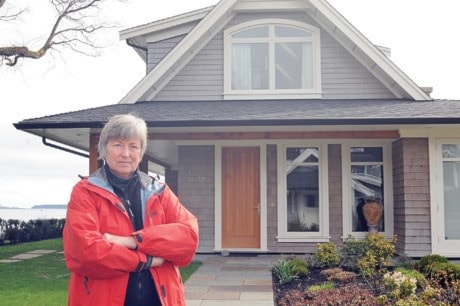Resident appealing decision archeology bill
When Wendi MacKay agreed to pay $5,000 toward an archaeological study of her Esplanade property four years ago, she had no idea she’d eventually end up paying 10 times that much.
Or that it would take a year and a half for construction to begin on her house.
“They were digging by little slices and then they would sift, scrape, and sift some more,” MacKay said, describing how a team of archeologists worked for eight months on her beachfront lot.
The retired lawyer and her husband bought the property in 2005 from her parents, who had owned it for 22 years. There was nothing on title to alert MacKay of any archeological significance attached to the land.
In 2007, the year her husband died, her architect recommended she have an archeological assessment done. That $6,000 assessment recommended further study, with a $30,000 price tag.
MacKay wound up hiring a different firm whose estimate came in at $51,000, “but that was to be for everything: digging, reporting, testing,” she said.
Eight months later, with four to six workers on the site every day, the archeology bill had risen to $61,000 and the firm told her they’d need another $30,000 to $40,000 to finish the job.
After protracted discussions with the archeology branch of what is now the B.C. Ministry of Forestry, Lands and Natural Resource Operations – it mandates that such studies are done before construction begins – MacKay was OK’d to take out a building permit.
To limit the expensive archeological process, she proposed the house be built on pilings rather than a poured concrete basement. But even those pilings created a controversy. Members of the Songhees First Nation blockaded the property, demanding that more work be done.
That dispute was resolved, work was completed and the house built, but MacKay took the archeology branch to court to recoup costs, including increased construction expenses, in the amount of $600,000. She lost that bid in B.C. Supreme Court last month, but plans to appeal.
MacKay thinks the province should be helping homeowners with archeological survey costs.
“I think the government should pay for it all, but assuming they don’t … they should at least put notice on people’s title so that when somebody buys, they know they can make reasonable decisions.”
The ministry says registered archeology sites are on property titles. But even though an in-depth study of MacKay’s property had been done in the summer of 1972, the site was not registered. A ministry spokesperson said that checking with the branch should be de facto for property buyers, “just like you would check with a home inspector.”
Esquimalt-Royal Roads MLA Maurine Karagianis has several times introduced a private member’s bill in the legislature asking that a program be established to assist with costs protecting and stewarding important archeology sites in B.C. It has yet to be approved by government.
“There’s a real conflict between the desire and right of First Nations to protect history and heritage and … landowners who believe they should have the right to build without incurring these huge bills,” she said.
Songhees archeology technician Ron Sam is currently consulting with archeologists on about 20 Greater Victoria sites involving private land. The surveys are invaluable to the Songhees, he said.
“It’s part of who we are – it’s our past, our people. Big or small, it’s got to be done.”
MacKay now has a 3,000-square-foot house on the carefully landscaped property with spectacular water views.
“But was it worth it? I don’t know,” she said.
vmoreau@oakbaynews.com
